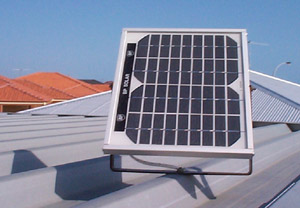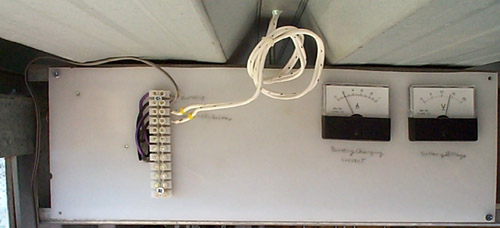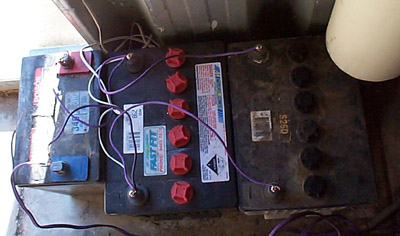I experimented with a few small solar projects in the early 2000's, if you want to know about solar panel installation for your house I have written about it here.
Early 2000 and I was given a Dick Smith gift voucher. I could have spent it on many things such as PC consumables, or something more lavish like a game or a host of other "conventional" stuff but I decided to do something else - and bought the biggest solar panel Tricky Dicky stocked at the time.
I had no plans to do anything particular with it but as any good tree huggin' engineer will tell you there is something enticing about creating power from "renewable resources".

Mounted on a home made bracket and tuned to the sun.
I grabbed a 12V 5W BP solar. I got it home and read some books. First thing I decided it should do was to charge up 12V batteries. However you can't just connect this type of solar panel straight up as it's open circuit voltage can get over 20 Volts - which would eventually fry your average 12V battery.
You need a regulator circuit to ensure that the voltage output never goes above 14V (a good 12V battery charging rule of thumb) and that current never travels back from the battery into the solar panel at night. I nabbed the following circuit (used without permission, sorry) from ETI and built it.

This regulator circuit achieves 3 things: battery cannot discharge into the panel, panel voltage can never go above 14.3V and even when the panel voltage output is as low as 6-7 volts it is still capable of charging a 12V battery.
Here's my personal quick rundown of the circuit:
- D3 stops current from flowing out of the battery and back into the circuit. Cost is a continous 0.7V off the top of the operating voltage (from using a didode) but it's the only way.
- ZD2 clamps the voltage at 14.3V (ie 15-0.7 of D3). If the batteries are fully charged the solar panel will try to bring them above 14.3V. Instead of that juice cooking the batteries it is burned off as heat in the 5W rated zener. Yep, it gets hot, potentially useful solar power is wasted to nothing. You get that.
- Pretty much the rest of the circuit is a capacitive doubling charge pump into C4. The 555 hard
switches Q1 at T= (R2+R3)*C2 = 3.1kHz. Looking at the arrangement of C3, D1, D2 and C4 you can see
when Q1 is on the negative plate of C3 is held close to ground and thus charges up to close to Vcc
via D1. C4 also charges up to close to Vcc. Now when Q1 turns off the negative plate of C3 is
forced to Vcc through R5 but it still has a charge of Vcc across it. Because of D1 does not allow
current back to Vcc, C4 now has 2xVcc across it, and thus the voltage is doubled.
Now this will find a stable level at the battery voltage but you can see that if Vcc drops to 6-7 volts (ie a cloud goes across the panel) the output on the battery is still 12-14V. This is a nice feature, without it any solar panel output below the battery voltage would have no effect - but in this case that voltage is still useful.
As you can see I grabbed a couple of meters and "neatly" mounted them on a bit of placcy. I'd pefer it to be continuously logging data to my PC, but for now an instantaneous readout was fine.

Readout pictured was 0.2A @ 14V = 2.8W. Best I've seen is 0.32 @ 13.8V = 4.4W. I calculated the loss due to the regulator at 0.4W.
A couple of old car batteries lying around serve as the "battery bank". Car batteries are *not* suitable for solar sites. Car batteries do not like to be flattened, in fact they don't even like losing any charge. What you want are batteries that don't mind a deep cycle. Specially made lead acid batteries such as marine and gelcels can handle many deep cycles; where a deep cycle is defined as 50% charge used. Anything less is detrimental to the battery's health.
Nicads/ NiMH/ etc are much more suited as they actually don't mind being fully flattened - due in part to the fact that they do not consume the anode. However a better way of using solar power is to not use batteries at all - for example solar water pumping.
For now they are keeping the first spinoff solar project alive - the solar guitar amp.

Parallel those old car batteries...








 database
database